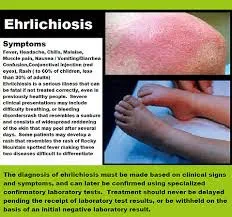Ehrlichiosis is a broad term used for infections caused by Ehrlichia bacterial species. The symptoms commonly seen with these infections include fever, headache, chills, malaise, muscle pain, nausea, vomiting, diarrhea, confusion, rash, and conjunctival injection. Symptoms will vary for individuals.
Ehrlichiosis can be a very serious disease if not treated correctly. Individuals who are immunocompromised are more likely to have severe disease.
Arizona will typically see 1 to 4 cases of ehrlichiosis reported each year.
Arizona 5 year median: 2 cases
Transmission
Transmission occurs from the bite of an infected tick. Blood transfusions and organ transplantation are also possible modes of transmission.
Incubation period is between 5 to 21 days.
Lab Tests & Specimen Info
Test*
|
Specimen
|
PCR
(this test should be used during the acute phase of the disease) |
Whole Blood
|
Serology
(Acute and convalescent specimens should be sent and the convalescent should be collected 2-4 weeks after the acute) |
Serum
|
Microscopic
examination (this test should be used during the first week of illness) |
Ehrlichiosis is not a communicable disease.
Standard precautions are recommended in healthcare settings.
Prevention for Patients
Reducing contact with ticks:
Reducing contact with ticks:
- use insect repellent
- wear long sleeves and pants
- avoid wooded areas and brushy areas with high grass
- perform thorough tick checks after spending time outdoors
Public Health Actions
If an individual develops ehrlichiosis within a month of receiving a blood transfusion or solid organ donation this case should promptly be reported to public health so an investigation can be completed.
If an individual develops ehrlichiosis within a month of receiving a blood transfusion or solid organ donation this case should promptly be reported to public health so an investigation can be completed.
Public health will conduct an epidemiological investigation on a case or suspect case. <!-- Global site tag (gtag.js) - Google Analytics -->
<script async src="https://www.googletagmanager.com/gtag/js?id=UA-109237959-1"></script>
<script>
window.dataLayer = window.dataLayer || [];
function gtag(){dataLayer.push(arguments);}
gtag('js', new Date());
gtag('config', 'UA-109237959-1');
</script>



No comments:
Post a Comment